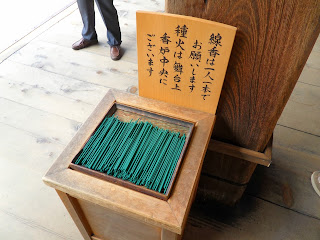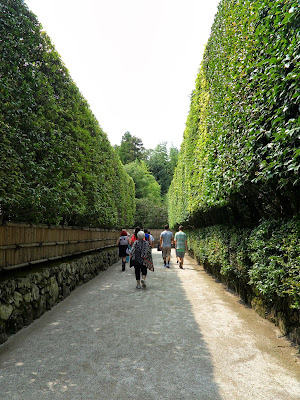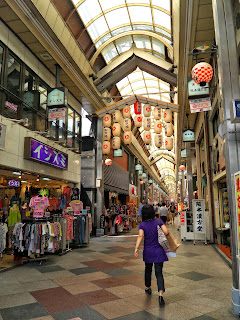

So our starting point is Kyoto. We arrived this morning at around 6 and immediately headed to our hotel to leave our baggage. We stayed at a hostel called K’s Hostel. It was decent for its price; rooms were clean and bathrooms were clean, but there were bunk beds (in a shared room for two that we reserved) and it was really small, but it was near the station, so it was okay.
Our first destination was Kiyomizu-dera, which is a very well-known Buddhist temple in Kyoto. It’s a pretty big temple located in a mountain. Aside from the temple itself, there are two big shopping streets with mainly souvenir shops and small restaurants.
 |
| The entrance of the temple. It was only eight in the morning, but it was already really hot. |
The inside of the actual temple (which, there is a ¥300 entrance fee) was really woody (haha), with wooden pillars, wooden floors, etc.


And there was an incense burner (one per person only).
They sold a lot of these amulets/charms (お守り, mamori meaning "protect"). Omamori are traditionally made of cloth and encloses paper or pieces of wood with prayer written on them. They should never be opened in order to avoid losing their protective benefits, and should be carried around either by tying it to a backpack or purse, etc. They are replaced once a year, but should not be thrown away with regular rubbish in a trash bin, as this indicates disrespect. Old omamori are usually returned to the same shrine or temple so that they can be disposed of properly, but they can also be burned as a sign of respect to the deity that helped the person out throughout the year.
Omikuji are fortunes or blessings (or curses) that you randomly draw from a box. I talked about this months ago when I visited my first temple in Japan.
Surprisingly, my friend and I drew the same fortune! haha
Though it's not the best fortune, it's still a good blessing.
Behind the main hall, there is a shrine called Jishu Shrine (地主神社), which is known as the cupid of Japan. It is dedicated to the deity of love and matchmaking.
 |
| handwashing custom |


Here is the love stone, which are two stones placed eighteen meters apart. If you can walk from one stone to the other with your eyes closed, you will have luck in finding love. However, if you cannot, it will be long before your love is realized. Would you take the risk?
Below the main hall is the Otowa Waterfall (音羽の滝), whose water is believed to have therapeutic properties.
The waters are divided into three streams of water that you can drink by using cups attached to long poles, each representing longevity, success at school, and a fortunate love life. However, drinking from all three is considered greedy.
 |
| The cups, which are sterilized with UV sterilizers. It was really heavy! |
 |
| The beautiful tree-lined pathway at the entrance to Ginkaku-ji. |
The sand garden of Ginkaku-ji, a carefully formed pile of sand.
This is Ginshadan (銀沙灘), the "sea of silver sand".

Kogetsudai (向月台), the "moon viewing platform", a two-meter cone-shaped sand mound. Some say this represents Mount Fuji, others say it reflects divine light into the hearts of the visitors. Either way, kogetsudai illuminates Ginkaku-ji on moonlit nights, and the view of it from above resembles the full moon reflected in a deep lake.
 |
| Kinkyo Pond 錦鏡地 |
 |
| The red dot in the middle of the picture is a Chinese parasol tree, which is a descendent of one of the trees affected by the Hiroshima atomic bombing. |
Nearby Ginkaku-ji is the Philosopher's Walk, which is a cherry blossom-lined pathway that takes about thirty minutes to walk through. The name comes from an influential 20th-century Japanese philosopher, Nishida Kitaro, who used to walk this path for daily meditation.


Nijo Castle was built in 1603 by the first shogun of the Tokugawa shogunate, Tokugawa Ieyasu. It was meant to be the official Kyoto residence of the emperor. Therefore, the interior of the palace was constructed with “nightingale” floors, where the wooden floors were purposely designed to creak to alert them of any intruders.
 |
| Ninomaru Palace 二の丸御殿 |
Ninomaru Garden, a traditional Japanese landscape garden with a large pond, ornamental stones, and manicured pine trees.
 |
| Honmaru Palace 本丸御殿 Not usually open for public viewing. |
Around two in the afternoon, we went to the Kyoto city center to look for a place to eat. We walked through a shopping street called Shinkyogoku where there were many clothing shops, shoe shops, cosmetics shops, traditional wear stores, accessory stores, etc. There were also several restaurants. My friend was craving katsudon, though, so we went in search of it. If you are someone who cannot live without katsudon, though, please do not come to Kyoto, because you will not find it. lol We walked through the entire shopping street and didn't even find one. In the end, we settled for a place that served something similar.
 |
| architecture of downtown Kyoto |
Cold taiyaki! So strange o.0 I still prefer the hot ones.


The restaurant we settled for. It wasn't too bad, but they had katsudon. The difference between tonkatsu and katsudon: tonkatsu is deep-fried cutlet (either pork, chicken, fish, etc) and katsudon is the same thing with rice underneath. I don't really see the difference, besides the rice, but apparently, it's not the same. =\
After lunch, we headed northwest for Kinkaku-ji and Ryoan-ji. However, we were already nearing the closing time of the temples (which is 17:00), so we were only able to go to one.
 |
| Ryoan-ji (龍安寺) is the "Temple of the Dragon at Peace", a zen temple founded by a monk in 1450. |
This is the Ryoan-ji tsukubai (蹲踞), which literally means "crouch". It is a water basin very lowly set, so the user must bend over to use it, in a sign of reverence and humility. The kanji on the surface reads 五, 隹, 止, 矢, which, when read alone, have no significance. However, the opening of the basin forms a square, which is the kanji 口, meaning "mouth" or "aperture". When combined with the 口 radical, the kanji then becomes 吾, 唯, 足, 知, respectively, which reads "ware tada taru (wo) shiru" and translates literally as "I only know (what is) enough". In other words, simply, what one has is all one needs, which is the basic teaching of Buddhism (to eliminate desire).
 |
| The temple building (for viewing only). |
 |
| Kyoyochi Pond 鏡蓉池 |
 |
| Lit-up shrine. |
shrine guardians


There were still some people walking around the shrine, holding flashlights. At one point, the path split into two. It was really dark and quiet, though, so we (my friend and I) refused to split up. Plus, the trees and the wind just created shadows and sounds that added to the creepiness.
 |
| A pile of torii figures. |
 |
| lost and confused |
By the way, Kyoto is mainly a bus city, so if you are ging on the 18kippu, I suggest waiting until you travel outside of Kyoto to use it, because there is a very cheap ¥500 one day bus pass that you can purchase. Regular bus fares cost ¥220, so if you plan on using the bus more than twice (which I think is a good idea at the end of July because it is blazing hot!), buying the pass would be ideal.




























No comments:
Post a Comment